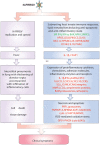Understanding PRRSV infection in porcine lung based on genome-wide transcriptome response identified by deep sequencing
- PMID: 20614006
- PMCID: PMC2894071
- DOI: 10.1371/journal.pone.0011377
Understanding PRRSV infection in porcine lung based on genome-wide transcriptome response identified by deep sequencing
Abstract
Porcine reproductive and respiratory syndrome (PRRS) has been one of the most economically important diseases affecting swine industry worldwide and causes great economic losses each year. PRRS virus (PRRSV) replicates mainly in porcine alveolar macrophages (PAMs) and dendritic cells (DCs) and develops persistent infections, antibody-dependent enhancement (ADE), interstitial pneumonia and immunosuppression. But the molecular mechanisms of PRRSV infection still are poorly understood. Here we report on the first genome-wide host transcriptional responses to classical North American type PRRSV (N-PRRSV) strain CH 1a infection using Solexa/Illumina's digital gene expression (DGE) system, a tag-based high-throughput transcriptome sequencing method, and analyse systematically the relationship between pulmonary gene expression profiles after N-PRRSV infection and infection pathology. Our results suggest that N-PRRSV appeared to utilize multiple strategies for its replication and spread in infected pigs, including subverting host innate immune response, inducing an anti-apoptotic and anti-inflammatory state as well as developing ADE. Upregulation expression of virus-induced pro-inflammatory cytokines, chemokines, adhesion molecules and inflammatory enzymes and inflammatory cells, antibodies, complement activation were likely to result in the development of inflammatory responses during N-PRRSV infection processes. N-PRRSV-induced immunosuppression might be mediated by apoptosis of infected cells, which caused depletion of immune cells and induced an anti-inflammatory cytokine response in which they were unable to eradicate the primary infection. Our systems analysis will benefit for better understanding the molecular pathogenesis of N-PRRSV infection, developing novel antiviral therapies and identifying genetic components for swine resistance/susceptibility to PRRS.
Conflict of interest statement
Figures







References
-
- Albina E. Epidemiology of porcine reproductive and respiratory syndrome (PRRS): an overview. Vet Microbiol. 1997;55:309–316. - PubMed
-
- Baoqing G, Zhangshui C, Wenxing l, Yizhu C. Isolation and Identification of Porcine Reproductory and Respiratory Syndrome(PRRS) Virus from aborted fetuses suspected of PRRS. Chinese Journal of Preventive Veterinary Medicine. 1996:1–5.
-
- Carlsson U, Wallgren P, Renstrom LH, Lindberg A, Eriksson H, et al. Emergence of Porcine Reproductive and Respiratory Syndrome in Sweden: Detection, Response and Eradication. Transbound Emerg Dis 2009 - PubMed
-
- Neumann EJ, Kliebenstein JB, Johnson CD, Mabry JW, Bush EJ, et al. Assessment of the economic impact of porcine reproductive and respiratory syndrome on swine production in the United States. J Am Vet Med Assoc. 2005;227:385–392. - PubMed
-
- Cavanagh D. Nidovirales: a new order comprising Coronaviridae and Arteriviridae. Arch Virol. 1997;142:629–633. - PubMed
Publication types
MeSH terms
Substances
LinkOut - more resources
Full Text Sources
Molecular Biology Databases

